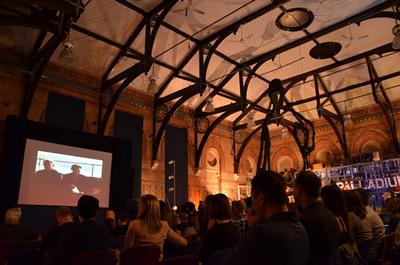“Border Crossings” event launches the new Centre for International Film Research

On 2 July 2016 University of Southampton’s Film Department invited students, academics and the general public to join them at the Cinema Museum in south London for a one-day symposium to celebrate the university’s new Centre for International Film Research (CIFR); a research centre that provides an interdisciplinary forum for research into film. CIFR will showcase the university’s research excellence while engaging wider communities through public events, visiting speakers, and research initiatives.
This inaugural event was titled “Border Crossings” and explored the ways in which film entails a range of “Border Crossings”, whether geographical, political, industrial, metaphorical, or aesthetic. Globalisation and transnational flows are pressing political contemporary concerns, and film throughout its history has been both a product of, and a stimulus for, international exchange. From its intermedial origins to present-day digital convergence film has been caught up amidst a range of intersecting borders. By bringing together key scholars in the field, the papers, screenings, and debates of this event aimed to open up new perspectives on this critical domain.
After a welcoming address from Film’s Head of Department Professor Lucy Mazdon, the programme opened with three of the department’s newest colleagues presenting their research. Dr Louis Bayman’s paper “Sic transit: Travel in serial killer films” investigated journeying as a motif in serial killer films and positioned this motif in relation to debates on mobility, modernity and serial killing. Dr Ruby Cheung then discussed cross-border film business activities in East Asia in her talk: “The Border-crossing Effects of Film Policies: Contemporary East Asian Film Business Networks”. Finally, Dr Corey Schultz analyzed the peasant migrant worker figure in contemporary Chinese cinema in his presentation: “A Need for Roots? The Floating Population and Precarious Migration in Jia Zhangke’s Films”. Afterwards, Dr Mike Hammond joined the speakers in a discussion with the audience.
After a lunch break where the speakers and audience had a chance to admire the impressive film memorabilia collections at the Cinema Museum, another of the Film department’s new colleagues – Dr Malcolm Cook – provided an in-depth introduction to the experimental animation films by Len Lye. In collaboration with the BFI National Museum we were able to screen five Len Lye films, to the utter enjoyment of the audience. The first one, Tusalava (1929) was screened with live accompaniment by Dr Mike Hammond and Alex Hammond of the Dodge Brothers. It was followed by Experimental Animation/Peanut Vendor (1933), A Colour Box (1935), Trade Tattoo (1937) and, finally, Rainbow Dance (1936).
In the closing section of the day Professor Lucy Mazdon chaired a round-table discussion on the theme of “Border Crossings” with a number of leading scholars in the field: Professor Laura Rascaroli (University College Cork), Professor Lúcia Nagib (University of Reading), Dr Karl Schoonover (University of Warwick), Professor Dina Iordanova (University of St Andrews) and Professor Paul McDonald (King’s Colleague London). The invited speakers each presented some thoughts in answer to questions such as: “What challenges are posed to how we understand film by the increasing transnational nature of its financing, production, distribution, exhibition and reception?” and “What role is played by film, and Film Studies, in contemporary issues of migration, diaspora and globalization?”. The audience was then invited to join the discussion with the speakers, resulting in a lively and engaging debate.
The symposium was very well attended, and CIFR plans to follow up with plenty of other exciting events in the future.
.JPG_SIA_JPG_fit_to_width_XL.jpg)
.JPG_SIA_JPG_fit_to_width_XL.jpg)
%20landscape.jpg_SIA_JPG_fit_to_width_XL.jpg)
.JPG_SIA_JPG_fit_to_width_XL.jpg)